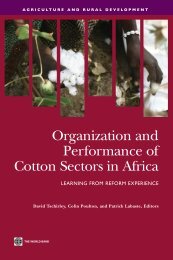Constraints to smallholders participation in Cassava value ... - aaacp
Constraints to smallholders participation in Cassava value ... - aaacp
Constraints to smallholders participation in Cassava value ... - aaacp
Create successful ePaper yourself
Turn your PDF publications into a flip-book with our unique Google optimized e-Paper software.
It was noted that although farm sizes were small, access <strong>to</strong> land is not a constra<strong>in</strong>t and farmerswish<strong>in</strong>g <strong>to</strong> expand landhold<strong>in</strong>gs could apply <strong>to</strong> local authorities. Farm size was <strong>in</strong>versely related <strong>to</strong>proximity <strong>to</strong> the road.3.2 Agricultural systemRegard<strong>in</strong>g agricultural production, manyokola was the dom<strong>in</strong>ant cassava variety, the first choice ofover 50% of growers. Among cassava growers, the attributes of improved varieties were more highlyappreciated than those of the traditional varieties. In addition <strong>to</strong> maize and cassava, most growerscultivated groundnuts (78%) and sweet pota<strong>to</strong> (57%), with soya, sorghum, sunflower, vegetables andbeans as other crops <strong>in</strong> a mixed system. 69% of respondents claimed <strong>to</strong> have <strong>in</strong>come sources <strong>in</strong>addition <strong>to</strong> that derived from lives<strong>to</strong>ck sales and labour<strong>in</strong>g. Most commonly, this was the sale ofagricultural produce (24% of the <strong>to</strong>tal), and the rest was a variety of salaried and occasional/casualemployments, local self-employment, and remittances (4% only).3.3 <strong>Cassava</strong> productionUptake of cassava production by respondents was low through most of the 1990s and then receiveda boost <strong>in</strong> 1997. The acceleration of production received another large boost <strong>in</strong> 2007 and 2008. Ofthe 88 cassava growers, 65% of the sample, said that over a period of the last three years they had<strong>in</strong>creased the area of cassava grown (from an <strong>in</strong>crease of 0.3 limas <strong>to</strong> a maximum <strong>in</strong>crease of 14limas, with 9% unsure) and 21% said that they had decreased the area grown, by a range of 0.1 <strong>to</strong>2.75 limas). For 18% of growers there had been no change <strong>in</strong> area. One respondent, whose farm sizewas 25 limas, had expanded the cassava area by 14 limas. The socioeconomic data for this growerwere unremarkable except that he owned a hammer mill and had been grow<strong>in</strong>g cassava s<strong>in</strong>ce 1998.3.4 Household heterogeneityDifferences between household groups were identified by cross-tabulation and chi 2 tests <strong>in</strong> respec<strong>to</strong>f farm scale, commercial orientation and level of organisation:Compared with other growers, grower/sellers of IVs:• cultivated larger areas of cassava (p
















